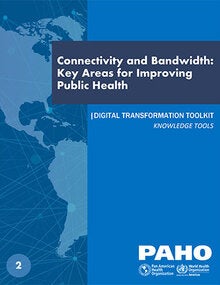For efficient and effective implementation of technology in the public health agenda, connectivity and bandwidth are critical for success both globally and in the Region of the Americas. Digital connectivity for all can enrich health service delivery, improve the quality of service and patient safety, and increase the efficiency and coordination of care. Through digital solutions, governments and health-related institutions can expand the possibility of individuals to playing an active role in maintaining their own health and well-being.
Geared to non-technical readers, this short publication explores why connectivity and bandwidth should be priorities in public health. Through intentionally brief sections, it illustrates the potential of connectivity and bandwidth for improving the sustainable flow of services to meet supply and demand requirements in public health. However, it also warns that they could exacerbate existing inequities and even give rise to new ones. It notes that already vulnerable populations and sections of society suffer more from a lack of connectivity. Thus, also in the field of technological and digital transformation, the approach must leave no one behind. The publication highlights this as a great challenge for public health policies across the Americas, which must solidify the promise of digital transformation to reduce disparities in health, social, economic, and digital capital among people in the Region.
The publication discusses various questions, such as what digital connectivity means and whether the Region is ready for the age of digital interdependence. It also shows how the issues relate to the Information Systems for Health Initiative, and to the Eight Principles for Digital Transformation of Public Health launched by the Pan American Health Organization in February 2021.
|

